|
 Postia manuka Postia manuka
SynonymsPoria manuka
Oligoporus manuka
BiostatusPresent in region - Indigenous. Endemic
Images (click to enlarge)
Caption: Fig. 10. Oligoporus manuka. A, part of hymenium; B, generative hyphae; C, spores. From the type
of Poria manuka (PDD 4122). |
Article: Cunningham, G.H. (1965). Polyporaceae of New Zealand. New Zealand Department of Scientific and Industrial Research, Bulletin 164: 304 p. Wellington:.
Description: Hymenophore annual, adherent, membranous-ceraceous,
effused forming linear or elliptical areas 2-4 x 0.5-1 cm, 0.25-1 mm thick.
Hymenial surface at first chalk white and translucent, drying dingy cream,
isabelline, or sometimes reddish-brown, not creviced; margin adherent, sharply
defined, 0.5 mm or less in width, white, fibrillose, irregular, adherent. Pores
not in strata, round or slightly angular, 2-3 or 3-4 per mm, 100-250 µm
diameter; to 1 mm deep, dissepiments 160-200 µm thick, equal, apices tufted.
Context white or pallid cream, 100-200 µm thick, of closely intertwined hyphae;
generative hyphae 3.5-4 µm diameter, walls 1-1.5 µm thick, branched, septate,
slightly swollen at septa, with clamp connections. Hymenial layer to 25 µm deep,
a dense palisade of basidia and paraphyses embedded in mucilage. Basidia
subclavate, 8-12 x 3.5-4 µm, bearing 4 spores; sterigmata erect, slender, to 4
µm long. Paraphyses subclavate, 6-10 x 3-3.5 µm. Spores allantoid, 5-6 x 1.5-2
µm,walls smooth, hyaline, 0.1 µm thick.
Habitat: HABITAT: Bark and wood of standing
fire-killed stems and branches, associated with a brown ring rot.
Distribution: DISTRIBUTION: Australia,
New Zealand.
Notes: Common in the Tongariro National Park and vicinity, the
fungus produces a conspicuous brown ring rot in its host. It may be identified
by the monomitic hyphal system, allantoid spores, and waxy fructifications,
which form narrow linear areas upon the host tissues. Although sterile, the
Australian collection has been placed here as it agrees in other features. The
specific name was taken from the Maori name for Leptospermum scoparium.
Article: Cunningham, G.H. (1947). New Zealand Polyporaceae. 1. The genus Poria. New Zealand Department of Scientific and Industrial Research, Plant Diseases Division, Bulletin 72: 43 p.
Description: Hymenophore effused, elliptical, to 4 x 1 cm., 0.25-1 mm. thick, firm, at first chalky white and
translucent, becoming dingy cream, isabelline or sometimes reddish-brown when dry, waxy;
margin not lifting, sharply defined, abrupt, 0.5 mm. or less in width, white, floccose, irregular;
surface even, dissepiments not toothed. Pores round or slightly angular, not in strata, white or
pallid cream in section, to 1 mm. deep, 100-250 µ diameter, 2-3 or 3-4 to mm., irregular in size
and shape; dissepiments to 200 µ thick, somewhat thicker in old and young specimens, equal, of
woven hyphae, apex tufted with a dense mass of hyphae. Context 100-200 µ thick, woven, white
or pallid cream; generative hyphae hyaline, 3.5-4 µ thick, lumen about 1 µ, branched, septate,
clamp connections and bridging hyphae abundant, swollen slightly at the septa. Basidial type
merulioid, basidia clavate or subclavate, to 12 x 4 µ, cemented into a dense permanent palisade.
Spores allantoid, appreciably curved, 5-6 x 1.5-2 µ, hyaline, smooth.
Habitat: HABITAT: Leptospermum scoparium Forst., on bark and wood of standing fire-killed stems and
branches.
Distribution: DISTRIBUTION: New Zealand.
Notes: Characters of the species are the firm, usually cream-coloured waxy hymenophore, moderately
thick though somewhat unequal dissepiments, thick-walled glassy hyphae of the context,
merulioid basidial type and allanoid [sic] spores. The specific name has been taken from the
Maori name of the host, upon which the fungus is common in the National Park.
Article: Buchanan, P.K.; Ryvarden, L. (1988). Type studies in the Polyporaceae - 18. Species described by G.H. Cunningham. Mycotaxon 31(1): 1-38.
Notes: This species belongs in Oligoporus Bref. because of the resupinate basidiocarp, monomitic hyphal
system with clamps at the septa, and the brown rot. Spores of O. manuka are cylindrical to allantoid
and 6-7.5 x 2-2.5 µm, which is larger than the measurements given by Cunningham (1947, 1965) of
5-6 x 1.5-2 µm.
|